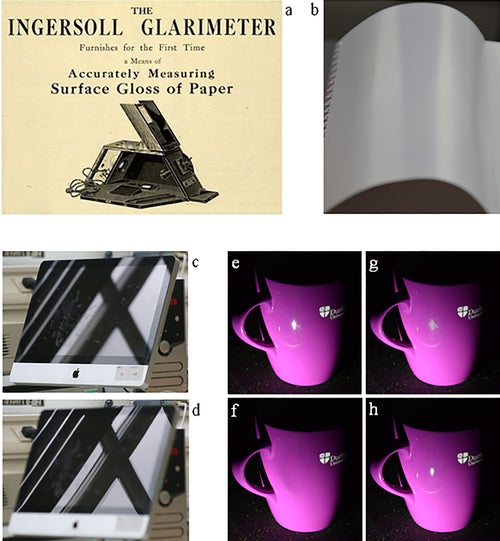This article was published in Scientific American’s former blog network and reflects the views of the author, not necessarily those of Scientific American
A new viral visual illusion has appeared on Instagram. A young artist has posted a picture of their legs, which are impossibly encased in shiny shrink-wrapped plastic. Or are they? The more you look at it, the more likely you will realize that the shell is not plastic, but rather bare skin with a few streaks of carefully applied white paint. And for many of you, it will then switch back to plastic again!
What makes this interesting, besides the wonderful artistry of the illusion, is that viewers report that they see either the glossiness or the streaks and that they tend to “get stuck” on one or the other percept (plastic vs. paint) for a long time. The illusion is bi-stable, which for a perceptual scientist is tantalizing and cool because it means we could study the same image in the same brain, while at the same time it is perceived in two distinct ways. The bistable-ness is, therefore, a function of the brain, and not a physical phenomenon of the stimulus itself. The stickiness is moreover reminiscent of the famous Dress illusion of last year—the first ambiguous color illusion known to be perceived differently by different cohorts of viewers, under the same exact lighting conditions (see my article in Scientific American Mind, with Susana Martinez-Conde and Bevil Conway, listed below, and also my blogs on The Dress too). It’s enough to make a neuroscientist salivate! An important discovery is in here somewhere!
It seems to me that the illusion of glossiness in the image is enhanced if you fixate the center of your gaze away from the thighs (on one of the knees, or on the feet, for example). This is a personal observation and I have no other data to back it up, so take it with a grain of salt. But if a future experiment verifies this observation in the population, my working hypothesis for why this occurs is that, when you fixate your gaze far from the thighs, your peripheral visual receptors are viewing the streaks of white, and therefore you cannot see the small imperfections in the paint, which are more evident when you view the paint with your central vision. Perhaps, if you can see the tiny cracks in the paint (with your high-resolution central vision), it helps your brain bias the bistability of the image away from gloss and towards paint. Whereas if the paint is viewed away from central vision, it is more ambiguous whether its paint or glossy and impossible skin. So you are more likely to see the gloss.
On supporting science journalism
If you're enjoying this article, consider supporting our award-winning journalism by subscribing. By purchasing a subscription you are helping to ensure the future of impactful stories about the discoveries and ideas shaping our world today.
Nobody has yet explained the bistable nature of the illusion—it might take a while to work it out. I’ll report back when we know more. But the nature of glossiness itself is incredibly interesting and mysterious, so let’s go over what scientists current know about that. A. C. Chadwick and R. W. Kentridge, of Durham University, wrote a scientific review of the topic recently. In it, they review the literature and show that people have been explicitly searching to explain what glossiness perception is for less than 100 years. The seminal work on the topic, by L. R. Ingersoll of the University of Wisconsin, was driven by the industrial need to measure the glossiness of paper. His and subsequent studies focused on the contrast between the specularities (bright reflective spots) on the surface and the non-specular parts of the same surface, as a means of measuring the glossiness: the higher the contrast, the glossier the surface. He proposed a device called a glarimeter that would measure the gloss of paper. Despite work in the 1930’s by Richard S. Hunter of the National Bureau of Standards, which suggested that the perception of gloss was a constellation of factors, Ingersoll’s fundamental idea based on specular contrast persisted and enjoyed undue popularity until the 1990’s, when Sève wrote an influential review that clearly showed that specular contrast was not enough, ushering vision science field into a period of self-reflection for about a decade.

A figure from the Chadwick and Kentridge review. (a) Ingersoll’s paper introducing the Glarimeter from 1922. Reproduced under the Creative Commons license. (b) The glossy sheen of paper seen at grazing angles. (c) When the blemished surface of a glossy video monitor is in focus, the surface is less glossy than when (d) the reflected image is in focus. (e) A photograph of a shiny coffee cup. (f) The same cup with all highlights removed: this shows that specularities of light do indeed contribute to glossiness, as, without them, the surface looks matte. (g) reducing the contrast of the highlight reduces the glossy quality, as does (h) reducing the haze surrounding the highlight.
More to see:
Macknik SL, Martinez-CondeS, (2015). “The Dress.” Scientific American Mind ( July-Aug )
https://blogs.scientificamerican.com/illusion-chasers/the-current-biology-of-the-dress/
Hunter, R. S. (1937). Methods of determining gloss. Journal of Research of the National Bureau of Standards, 18(1), 19–41.